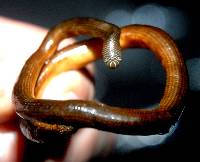
August 27, 2008
According to The Fiji Times for Thursday, August 28, 2008, an entirely new snake species has been discovered at Vuna on Taveuni, Fiji.
Or perhaps it is a “rediscovery”? A blind snake reportedly from Vuna, Taveuni was exhibited at a formal meeting of the Members of the Linnaen Society of New South Wales in 1897. The specimen has never been found and the record regarded as suspect. However Allan Gortan, the owner of the Paradise Taveuni Resort has recently procured a new specimen in the resort garden, reportedly where they are quite regularly found.
NatureFiji-MareqetiViti, a conservation organization, says this new species is not only new to Fiji but has not been found anywhere else in the world.
The snake is a small, blind, burrowing snake. It is shiny black in color (although in the photograph above it appears red-brownish), reaches about 25 cm in length, and is harmless.
A preliminary reaction from Dr. George Zug of the Smithsonian Institution in Washington D.C., the world authority on Fiji’s reptiles, is that this is unlike any other described species of snake in the world.
+++
Dr. George Zug is one of the founding members of the now-defunct International Society of Cryptozoology (ISC). He was actually the host of the charter meeting held at the Smithsonian on January 8-9, 1982, and named the first director of the board of directors of the ISC. He was involved in the initial investigations of cases such as the Mansi photograph of the Champ cryptid and the Frew videotape of the alleged Chessie Sea Serpent. It is welcome news to hear that Dr. Zug is still alive and well, and engaged in continued research. He is a significant figure in the history of cryptozoology.
Dr. George Zug clowns around with a replica of an elusive Myanmar snake on location there in 2003.
Dr. Zug, shown above behind some friends and their snake, is a coauthor of two reference books frequently used in the field, Snakes: Smithsonian Answer Book (Washington: Smithsonian Books, 2004), and Herpetology. An Introductory Biology of Amphibians and Reptiles (San Diego: Academic Press, 2001). – Loren
+++
A survey undertaken by NatureFiji-MareqetiViti in conjunction with the Taveuni Paradise Resort has revealed that most farmers in south Taveuni are quite familiar with the Ngata ni qele, though they only see it rarely when digging their gardens or in the forests for wild yams.
“This snake is a classic example of how little we know about the very special wildlife which we have in our own backyard, and provides all the more encouragement for NatureFiji-MareqetiViti in its ambition to get Fiji’s youth informed, interested and active in the conservation of the nation’s wildlife” Nunia Thomas, Conservation Coordinator, NatureFiji-MareqetiViti.
About Loren Coleman
Loren Coleman is one of the world’s leading cryptozoologists, some say “the” leading living cryptozoologist. Certainly, he is acknowledged as the current living American researcher and writer who has most popularized cryptozoology in the late 20th and early 21st centuries.
Starting his fieldwork and investigations in 1960, after traveling and trekking extensively in pursuit of cryptozoological mysteries, Coleman began writing to share his experiences in 1969. An honorary member of Ivan T. Sanderson’s Society for the Investigation of the Unexplained in the 1970s, Coleman has been bestowed with similar honorary memberships of the North Idaho College Cryptozoology Club in 1983, and in subsequent years, that of the British Columbia Scientific Cryptozoology Club, CryptoSafari International, and other international organizations. He was also a Life Member and Benefactor of the International Society of Cryptozoology (now-defunct).
Loren Coleman’s daily blog, as a member of the Cryptomundo Team, served as an ongoing avenue of communication for the ever-growing body of cryptozoo news from 2005 through 2013. He returned as an infrequent contributor beginning Halloween week of 2015.
Coleman is the founder in 2003, and current director of the International Cryptozoology Museum in Portland, Maine.
Filed under Breaking News, Cryptotourism, CryptoZoo News, Cryptozoologists, Cryptozoology, Men in Cryptozoology, New Species